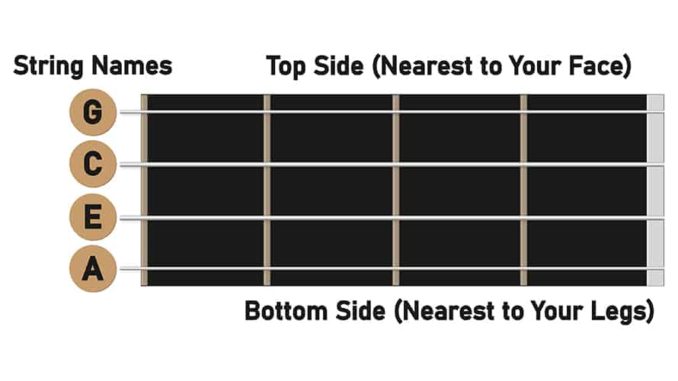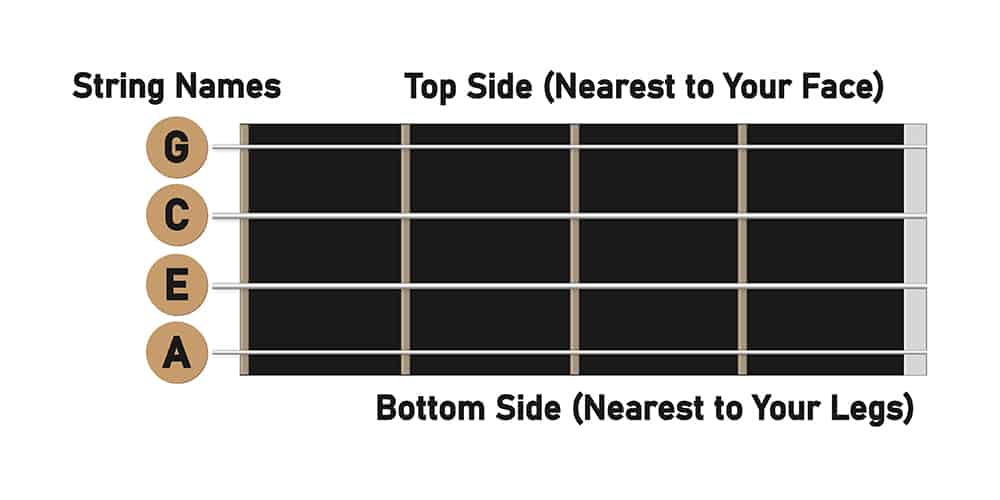
The ukulele, or Uke, with its enchanting melodies and portability, has captured the hearts of musicians worldwide. But for beginners, the seemingly simple instrument can present a challenge: understanding the string order and thickness. This guide unravels the mysteries of ukulele strings, equipping you to confidently navigate your instrument and unlock its full potential.

Ukulele String Thickness or Gauge
String Order: A High G Affair
Unlike the standard guitar tuning (E-A-D-G-B-E), the ukulele employs a unique “re-entrant” tuning, meaning the string order doesn’t strictly follow a low-to-high pitch sequence. Here’s the breakdown:
- 4th String (Top String): This is the highest pitched string and is tuned to G (an octave above middle C). It’s often called the “high G” string.
- 3rd String: Tuned to C (middle C), this is the second-highest pitched string.
- 2nd String: This string is tuned to E (above middle C), making it the third-highest pitched string.
- 1st String (Bottom String): The lowest pitched string, it’s tuned to A (above the E string on the 2nd string).
Memorizing the Order:
There are a few tricks to memorize the string order:
- High G at the Top: Remember, the “high G” string is always at the top (closest to your face when holding the ukulele).
- CEA-G Makes Music: This mnemonic device uses the first letter of each string name (C, E, A, G) to form a phrase you can easily remember.
String Thickness: Unveiling the Gauges
Ukulele strings come in various thicknesses, measured in gauges (thousandths of an inch). The thickness affects the sound, playability, and tension of the strings. Here’s a general overview:
- String 1 (A): Typically the thinnest string, ranging from 0.023″ to 0.028″.
- String 2 (E): Slightly thicker than the A string, gauges can vary from 0.027″ to 0.032″.
- String 3 (C): Often the thickest string on a soprano or concert ukulele, with gauges between 0.030″ to 0.037″.
- String 4 (High G): This string can be similar in thickness to the C string or slightly thinner, ranging from 0.028″ to 0.035″.
String Thickness Variations:
- Ukulele Sizes: String thickness can vary depending on the ukulele size. Soprano and concert ukuleles typically use the gauges mentioned above. Tenor and baritone ukuleles, with their larger bodies and lower tunings, often utilize thicker strings for better tension and sound projection.
- String Types: Ukulele strings are primarily made of nylon, but there are variations. Fluorocarbon strings offer brighter tones and better tuning stability, but may be slightly thicker than standard nylon strings.
Choosing the Right Strings: Finding Your Perfect Match
The ideal string thickness depends on your playing style, musical preferences, and ukulele size. Here are some factors to consider:
- Playing Style: For fingerpicking with a focus on melody, thinner strings might be easier to play. If you strum chords more aggressively, slightly thicker strings might provide a better balance between playability and tone.
- Musical Genre: Ukulele music encompasses various styles. For traditional Hawaiian music, standard nylon strings offer a warm, mellow sound. For brighter tones often associated with ukulele pop or strumming, consider fluorocarbon strings.
- Ukulele Size: As mentioned earlier, string gauges are often thicker for tenor and baritone ukuleles. Match the string set to your ukulele size for optimal playing experience and sound.
Experimentation is Key: Don’t be afraid to experiment with different string thicknesses to find what works best for you. Many ukulele players have their preferred string brands and gauges based on their needs and playing style.
By understanding the string order and thickness, you’ve taken a significant step towards mastering your ukulele. With a little practice and exploration, you’ll be well on your way to unlocking the boundless potential of this delightful instrument. Remember, the journey is just as important as the destination, so have fun strumming and creating your own ukulele magic!
Which Ukulele String Is the Thickest?
In a standard ukulele tuning (GCEA), the thickest string is typically the C string (3rd string from the top). It’s often the thickest because it’s the lowest pitched string and needs more mass to vibrate at a slower rate. However, on some ukuleles with a low G tuning, the low G string (4th string) might be the thickest.

Ukulele Articles
Ukulele tabs
10 TV Shows that Featured the Ukulele
Ukulele Lesson 1 – For Absolute Beginner
Hakuna Matata – Lion King – Ukulele Tutorial
How To Play ‘Can’t Help Falling In Love’ on Ukulele
How to Tune a Ukulele
